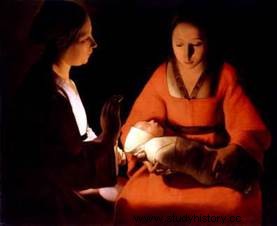 Among the many works of art evoking the nativity, there is one of a reality and a moving simplicity:"The New Born" by Georges de La Tour. It was the first "real" baby in the History of Painting that amateurs could compare to the child Jesus in the arms of his mother Mary. If this painting is famous, we have few elements on the life of La Tour, an artist forgotten until the end of the 19th century. His model being "Caravaggio", and he often used shadow and light in representing his religious scenes, contributing to the chiaroscuro style in vogue at his time.
Among the many works of art evoking the nativity, there is one of a reality and a moving simplicity:"The New Born" by Georges de La Tour. It was the first "real" baby in the History of Painting that amateurs could compare to the child Jesus in the arms of his mother Mary. If this painting is famous, we have few elements on the life of La Tour, an artist forgotten until the end of the 19th century. His model being "Caravaggio", and he often used shadow and light in representing his religious scenes, contributing to the chiaroscuro style in vogue at his time.
Georges de La tour, painter of chiaroscuro
Georges de La Tour, son of a baker, was born in 1593 and died in Lorraine in January 1653. He was probably introduced to artistic practice by Jacques Bellange in Nancy. He probably traveled to the Netherlands, as well as to Italy. A small provincial notable, he was introduced to the nobility of Lunéville thanks to his marriage to Diane Le Nerf, daughter of a wealthy treasurer, in 1619. The installation of his workshop in town was facilitated by the exemption from the payment of taxes. granted to him by Duke Henry II of Lorraine, but only his son Etienne was ennobled in 1670.
After the sack of Lunéville by French troops in 1638, he took refuge in Paris and became ordinary painter to King Louis XIII, for whom he had already painted in 1633 one of his famous "nights", today unidentified. Other amateurs figured among the Parisian clients of La Tour:Cardinal Richelieu and Chancellor Séguier, in particular. In the last ten years of his life, he received important public commissions from the town of Lunéville. Among them are four paintings which are the only works documented and identified with certainty. The reconstruction of all of his work is therefore very hypothetical.
 The paintings of La Tour are about religious themes or genre scenes. The composition is simplified to the essentials and the background decoration is absent, but the level of technical achievement is very high:the absence of drawing on the canvas, the touches which both color and define the contours. The most important element lies in the opposition between dark masses and extremely luminous details that create contrasts that the eye never encounters in nature. Iconography, relegated to the background of artistic interests, was then overtaken by a desire to reveal through painting an immediate but unexplored universe.
The paintings of La Tour are about religious themes or genre scenes. The composition is simplified to the essentials and the background decoration is absent, but the level of technical achievement is very high:the absence of drawing on the canvas, the touches which both color and define the contours. The most important element lies in the opposition between dark masses and extremely luminous details that create contrasts that the eye never encounters in nature. Iconography, relegated to the background of artistic interests, was then overtaken by a desire to reveal through painting an immediate but unexplored universe.
The newborn, by de La Tour
Made between 1645 and 1648, this painting depicts two serene women full of tenderness, surrounding a newborn baby, illuminated by the light of a candle. The mother is in adoration in front of this swaddled child she carries in her arms, the other woman who can be a midwife is certainly happy with this birth, with a touch of envy.
The use of chiaroscuro obtained through the play of candle light is one of the techniques mastered by Georges de La Tour when he was at the height of his art. The tones are warm, the shapes round and smooth, a very soft light spreads over this child.
This 76 x 91 cm painting on canvas, seized from a revolutionary in 1794, can be seen at the Musée des Beaux Arts in Rennes.
To go further
- The ABCdaire of Georges de La Tour. Flammarion, 1999.
- Georges de La Tour, by Jean-Pierre Cuzin. Citadels &Mazenod, 2021.
